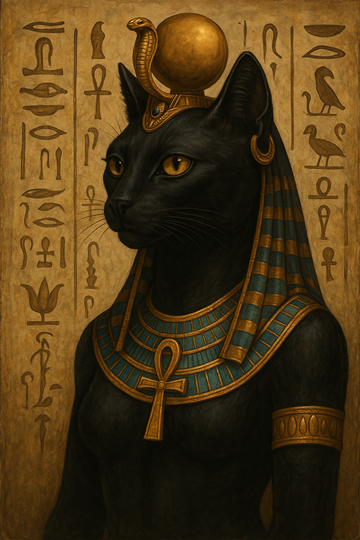According to earliest records, the first sign of domestication of the cat dates back 8,000 years ago when bones of cats, mice, and humans were found buried together on the island of Cyprus. Unlike the domestication of the dog, who are pack animals with a built-in cooperative instinct, the full domestication of the cat, which occurred about 4,000 years ago, was not so easily achieved.
Cats were held in high regard among the Egyptians who had laws to protect them. Due to the cat’s exalted status, a religious order of cat worship developed that lasted for more than 2,000 years. The cat goddess Bastet became one of the most revered figures of worship. Bastet had the body of a woman and the head of a cat.

The word for cat in ancient Egypt was “mau,” like our “meow,” a universal cat word. An inscription on the royal tombs in Thebes read: “Thou art the Great Cat, the avenger of the gods, and the judge of words, and the president of the sovereign chiefs and the governor of the holy Circle; thou art indeed…the Great Cat” During the reign of the Pharaohs, it was considered a capital crime to kill or injure a cat, even if the cat died through an unfortunate accident. If a house caught fire, the rule was… cats first, humans second. If a cat should die of natural causes the entire household went into elaborate mourning with chanting and pounding of chests as an outward sign of grief. The body of the cat had to be wrapped in linen and delivered to the priest who inspected the cat’s body to be certain he had died a natural death. After death the body was embalmed, wrapped again in linen, decorated and either buried in special cemeteries or entombed in temples.
Thousands of cat mummies were preserved in a huge temple at Bubastis. Mouse mummies were also found in the tombs, to assure that the cat had food for the journey into the afterlife. In fact, the Egyptians so loved their cats that cat mummies outnumbered human mummies. Over 300,000 cat mummies were found in one excavation alone at Beni-Hassan in the 1800s.
Because the Egyptians so prized their feline companions, there was a strict enforcement of the law against exporting cats. However, cats were so good at catching rodents they soon found their way aboard barges on the Nile River as mouse catchers and companions to captains and sailors. Cats soon sailed aboard ships to countries bordering the Mediterranean including Greece and Italy. Overland caravans lengthened the cat’s popularity to the north and east. Slowly cats migrated to India, China, and Japan, where they were highly prized as pets and impressive rodent killers.
Creatures Corner Fun Facts
More than 38% of cat owners scoop up the litter box once a day. Another 33% scoop it out twice a day and 16.6% only scoop 2 to 4 times a week.
77% of dogs and cats eat crumbs off the floor.
50% of dogs and cats like pressing their noses against windows.
23% of cats and 16% of dogs take advantage of the dubious little pleasure of drinking from the toilet.
Only one in one thousand animals born in the sea survives to maturity.
Related Articles & Free Email Newsletter Sign Up
Persian Cats Have Luxurious Fur and a Sweet Disposition
The British Shorthair Cat Has an Easy-Going Personality that is Great for Families



Comment here